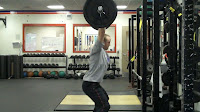Kettlebell swings are a great exercise. They have several different places in my programming, ranging from teaching a dynamic hip hinge on the way towards Olympic lifting, as a replacement for Olympic lifts because of an injury, as a "power endurance" tool, or a late season- low load/high velocity power exercise.
A good friend of mine, Jack McCormick from San Diego recently showed me this variation of the swing. By incorporating a band to the exercise, we can effectively increase the weight of the bell, which is helpful if you only have kettlebells of a certain weight.
Another purpose of the band is a concept known as "accommodating resistance". Similar to benching or squatting using chains or bands, the Kettlebell Band Swing allows for more emphasis on acceleration because the band acts like a breaking mechanism at the top of the swing. Basically you can extend the hips as powerfully as possible and not have to worry about decelerating the bell at the top, since the band pulls back as the bell moves up. It also speeds up the return of the bell during the swing, so it adds an eccentric overload which is hard to get any other way.
I really like this addition to the already great exercise, the kettlebell swing. I feel it has added a component of power to our program which is very beneficial.
Wednesday, February 15, 2012
Thursday, February 2, 2012
In Season Periodization
I recently had a great discussion with a Strength Coach friend of mine from California, Marcello Martinelli regarding how I periodize in season. He was curious if I use a conjugate or linear model meaning, if we typically lift twice a week, do I maintain the same volume and intensity on both days, or do I follow more of a higher percentage-strength based Day 1, and lower percentage-speed/power Day 2.
Well, I'll be honest when I tell you that all the different terminology still gets me turned around sometimes, but basically what I do is to follow a conjugate (I think) model during the in-season. However, I don't necessarily manipulate volumes and intensities between the two days, instead I let exercise selection determine the overall load on the system. In other words, we do follow a "Heavy day/ Light day" type of format, however I accomplish this by way of "exercise selection" variation, instead of a "percentage of maximum" variation.
Monday we will utilize the Hang Clean as our Olympic Lift variation to develop power, and Trap Bar Deadlift as our Lower Body Push to develop strength.
Wednesday we will follow the same template, however our Olympic Lift will be a Clean Grip Hang Snatch, and our Lower Body Push will be a Rear Foot Elevated Split Squat.
By setting up the exercises in this way on these days, we will have a higher total load on the CNS on Monday, because the loads used in Cleans and TBDLs are much greater than the loads used for Snatches and RFEs.
While the percentages, sets/reps of each lift will be about the same (ex. 85% TBDL x3x5 / 85% RFE x3x5) the overall load is much lower in the RFE.
Furthermore, I will alternate volume and intensity within the training session as well as week to week. So a 3 week phase might look like this:
Wk 1 5x80, 5x85, 5x82.5
Wk 2 3x82.5, 3x87.5, 3x85
Wk 3 5x80, 5x85, 5x82.5
The other exercises we utilize each day follow the same general guidelines, however if I am not using a percentage to dictate load, we will usually just follow a straight linear periodization throughout the phase, and then change the volume in the next phase.
For example, Day 1 we will usually do SLDL as our lower body pull, and Day 2 we will use Slideboard Hamstring Curl. Phase 1 may call for 2x8, while Phase 2 would call for 2x5. So we still try to have a "heavier" option Day 1 and a "lighter" option Day 2 with the exercise selection, and then let Progressive Resistance and Linear Periodization take over.
As an aside, I will admit that this is not always the case, as logistics sometimes dictate which exercise we can use effectively on a given day.
To continue to complicate things, we will progress or, perhaps more accurately, regress exercises as the season unfolds. The further along we get, the more I will shift the Power-Strength continuum towards power, as well as regressing exercises in difficulty. For example, even though Monday's are our "Heavy Day", at a certain point we start to lower the overall load in TBDL and add bands, so that we shift more towards developing a higher rate of speed rather than focusing on a higher level of strength. Down the line, we will move away from TBDL all together in favor of even less CNS demanding exercises. Day 2 will follow the same thought process, and will move from lower load, higher speed exercises, to a plyometric emphasis where we are all the way on the power side of the spectrum.
So the overall theme to my in-season periodization is to have a "Heavy" and "Light" day each week, however as you can see there is quite a bit of change, on several different layers that goes on from the micro to macro perspective. All in all the goal is to continue to address the things I believe are important in keeping my athletes as healthy as possible, as well as improve performance and manage stress and fatigue throughout the season. Nothing is ever set in stone, but this is a general synopsis of how I periodize in-season.
Subscribe to:
Comments (Atom)




